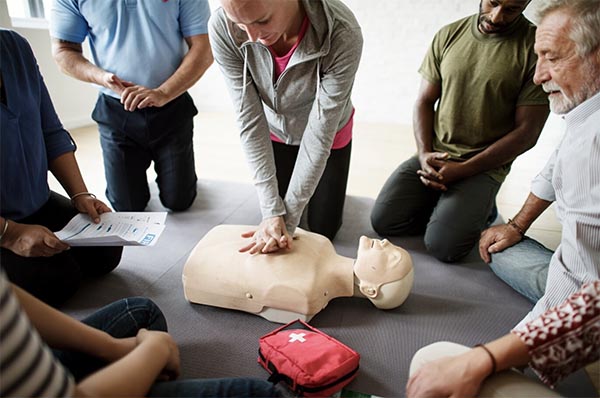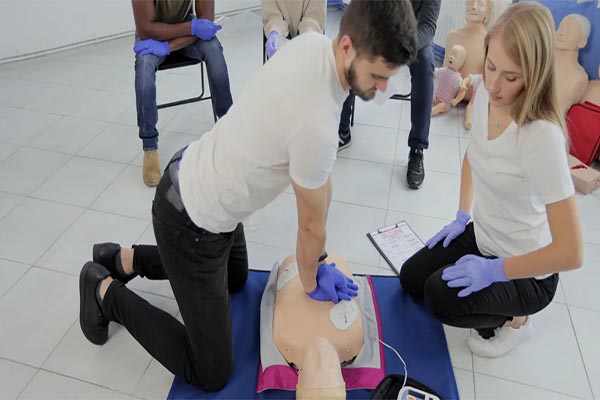
The pulse of any vibrant city, especially Baltimore, lies in its business district. From the towering finance centers to the bustling legal firms and high-tech startups, these environments are defined by fast-paced efficiency and professional excellence. However, within these spaces, an often-overlooked threat exists: sudden cardiac arrest.
Cardiac arrest is a stark reality, impacting thousands in U.S. workplaces annually. In a dense, complex urban environment like Baltimore, every minute counts, yet emergency response times can be unpredictable. The critical minutes, the gap between a collapse and the arrival of professional medical services, are often the only window of opportunity to save a life.
For companies in the Inner Harbor, Downtown, or surrounding business hubs, simply having a plan is no longer enough; immediate intervention is mandatory. This is where the strategic implementation of on-site CPR training transcends a mere safety box-ticking exercise and becomes a core business requirement. By bringing American Heart Association (AHA) certified training directly to the workplace, businesses ensure not only compliance but also the competence, confidence, and readiness of their entire team. This case study explores why convenient, standardized on-site training is the ultimate solution for corporate CPR compliance in Baltimore.
Why is CPR Training a Necessary Investment, Not Just a Requirement?
While it is tempting to view CPR certification as another mandatory compliance hoop, the financial and human resource benefits far outweigh the initial investment. Effective CPR training is a proactive business strategy designed to mitigate risk and protect human capital.
What exactly makes this training a necessity?
- The Survival Rate Ticking Clock: According to the American Heart Association (AHA), bystander CPR immediately after sudden cardiac arrest can nearly triple a victim’s chance of survival. For every minute that passes without intervention, the chance of survival decreases by approximately 7% to 10%.
- The Workplace Is Not Immune: Many employers mistakenly assume cardiac events only happen to high-risk individuals or in physically demanding jobs. The reality is that approximately 10,000 cardiac arrests occur in U.S. workplaces each year, often striking individuals with no prior heart-related symptoms.
- The “Chain of Survival” Starts with You: The established “Chain of Survival” dictates that the immediate recognition of an emergency and the quick activation of emergency response systems are the first critical links. The second link is early, high-quality CPR performed by a bystander, which, in a corporate setting, means a trained coworker.
- A Universal Life Skill: The skills learned in an AHA Basic Life Support (BLS) course, high-quality chest compressions, rescue breathing, and proper use of an Automated External Defibrillator (AED), are skills that travel with your employees. They are valuable in the office, at home, and in the greater Baltimore community.
Investing in comprehensive CPR training transforms employees from helpless bystanders into confident first responders, creating an internal layer of immediate emergency protection. This shift fundamentally alters the safety culture of the entire organization, establishing a professional and responsible image within the competitive business district.

How Does On-Site Training Streamline Corporate CPR Compliance?
For companies managing hundreds of employees across multiple departments in the Baltimore area, coordinating off-site training sessions can become a logistical nightmare. On-site training, delivered directly to your facility, solves this problem by transforming compliance from a complex administrative burden into a simple, single event.
How does this model specifically streamline compliance?
- Minimizing Operational Disruption: Traditional off-site training forces employees to travel, losing valuable working hours and creating scheduling chaos. By hosting the training on-site, employees remain in their work environment, easily accessible before or after their short training block, minimizing non-productive time.
- Ensuring Standardization Across the Board: When employees seek training from various individual providers, quality and curriculum can vary wildly, creating compliance gaps. On-site group training ensures every team member receives the exact same high-quality instruction, using the most current AHA protocols, from one trusted provider like CPR Classes Near Me.
- Addressing OSHA and Legal Requirements: The Occupational Safety and Health Administration (OSHA) requires employers to maintain a safe working environment under the General Duty Clause, Section 5(a)(1). While not all businesses are required to have CPR training, certain high-risk industries are, and providing it demonstrates proactive due diligence. On-site training creates an undeniable, uniform record of compliance.
- Centralized Record Keeping and Renewal: A core component of corporate compliance is tracking certification expiration dates. A dedicated provider offering on-site solutions, such as CPR Classes Near Me, manages the issuance of widely accepted AHA eCards and can implement a system to track renewals, ensuring no team member’s certification lapses.
- Superior Cost-Efficiency: The initial cost of on-site training, when negotiated as a group rate, often proves more cost-effective than reimbursing dozens of individual employees for separate courses, travel time, and mileage. The cost savings from reduced travel, centralized billing, and minimal lost work hours create a compelling return on investment (ROI).
On-site CPR training removes the friction points traditionally associated with workforce certification, allowing Baltimore companies to achieve and maintain compliance efficiently and economically.
What Unique Safety Challenges Does Baltimore’s Business District Face?
Baltimore’s business landscape is a rich tapestry of history, innovation, and industry, which presents a unique set of safety and compliance demands. The specific density and nature of the city require a specialized approach to emergency preparedness.
What distinct factors necessitate localized, on-site training?
- Urban Response Time Variability: While Baltimore has excellent emergency services, peak traffic times, road closures, and large events (like those around the Inner Harbor or Camden Yards) can significantly delay ambulance arrival. On-site training ensures a trained responder is immediately available, regardless of local traffic conditions.
- Diversity of Professional Settings: The business district includes a vast range of environments, each with unique hazards:
- Finance/Tech Offices: High-stress environments where long working hours may increase the risk of cardiac events.
- Construction/Port Facilities: Areas where physical injury and electrocution hazards make immediate First Aid and CPR crucial.
- Tourism/Hospitality: High foot traffic means businesses have a responsibility to employees and customers.
- Training in a Familiar Context: On-site instruction allows employees to practice emergency response in the exact setting where a real event would occur. Instructors can use the company’s specific floor plan, identify the location of the on-site AED, and simulate scenarios specific to the office layout. This contextual familiarity is invaluable under pressure.
- The Need for Local Expertise: A provider based in or deeply familiar with the Baltimore area understands the local employment and regulatory landscape. They can tailor training to the specific needs of a Maryland-based corporation, ensuring the BLS skills meet local professional requirements.
Choosing an on-site solution provided by a local expert ensures that the training is not a generic curriculum but a tailored, highly relevant preparedness strategy perfectly suited to the realities of the Baltimore business district.
What are the Tangible Business Benefits of a CPR-Trained Workforce?
Beyond compliance and convenience, the decision to invest in on-site CPR training yields significant, quantifiable benefits that impact the company’s financial health, legal standing, and internal culture. This is the true Return on Investment (ROI) of prioritizing life safety.
Here is how a fully trained workforce delivers value back to the organization:
- Drastic Reduction in Legal and Liability Exposure:
- A company that has demonstrably provided high-quality, up-to-date CPR and AED training is in a much stronger legal position than one that has neglected emergency preparedness.
- Having a trained team acts as a strong defense against negligence claims should a workplace emergency occur.
- Trained employees are protected under Good Samaritan Laws, which in the U.S. generally shield individuals who attempt to provide reasonable emergency assistance from liability.
- Enhancement of Employee Confidence and Morale:
- Knowing that a colleague is prepared and capable of acting in a life-or-death situation fundamentally increases an employee’s sense of security and value.
- Training transforms worry and fear into competence and preparedness, boosting overall team morale and fostering a supportive workplace culture.
- Group training sessions also serve as a unique, low-stress team-building activity, enhancing collaboration and communication skills under pressure.
- Potential for Insurance and Financial Savings:
- Businesses with robust, documented safety and emergency response programs may qualify for reduced liability insurance premiums or worker’s compensation rates. Insurance carriers often recognize a certified workforce as a lower risk.
- By reducing the risk of a fatal or debilitating outcome from a cardiac event, the company minimizes the potential for long-term health claims, high medical costs, and costly lawsuits.
- Fostering a Culture of Safety and Responsibility:
- When senior leadership participates in and prioritizes on-site training, it sends a clear message that employee wellness is a core value, not just a policy.
- A company culture that embraces safety sees higher employee retention and a greater willingness among staff to take proactive measures to protect their colleagues and the business’s assets.
The benefits of a CPR-trained workforce are not merely anecdotal; they are realized through minimized risk, legal security, and a more engaged, confident employee base, solidifying the business’s reputation as a responsible employer in the Baltimore market.

Why is Choosing an AHA-Certified, Local Provider Essential for Baltimore Companies?
When outsourcing life-saving training, the choice of provider is the single most critical decision a business will make. The difference between an official, recognized certification and a generic online course can be the difference between compliance and a liability risk.
Why should Baltimore businesses rely on an AHA-certified, local specialist?
- The American Heart Association (AHA) Standard is the Gold Standard:
- The AHA Basic Life Support (BLS) certification is the most widely recognized and accepted credential across healthcare, corporate, and governmental sectors nationwide.
- Choosing an AHA-certified training site, like CPR Classes Near Me, ensures that the skills being taught reflect the absolute latest, scientifically-proven life-saving protocols.
- The Power of Local Expertise and Infrastructure:
- A local Baltimore provider has instructors who are familiar with the area and are dedicated to serving the regional business community, including Annapolis, Towson, Columbia, and surrounding Maryland regions.
- They are uniquely equipped to understand and tailor the training to the specific demographics and environmental factors of your business setting.
- Hands-On Training is Non-Negotiable:
- Most employers and regulatory bodies do not accept certifications obtained exclusively online. Effective CPR requires hands-on practice, feedback, and demonstration of proficiency.
- The on-site model ensures instructors bring all necessary, state-of-the-art training equipment, mannequins, AED trainers, etc., directly to your location for a mandatory skills assessment.
- Immediate Proof of Compliance:
- CPR Classes Near Me provides Same-Day eCards upon successful completion of the course. This instant digital certification eliminates waiting periods, providing immediate, verifiable proof of compliance that is ready for corporate records or regulatory audits.
Choosing a provider that combines the gold standard of AHA certification with the logistical ease of on-site delivery in the Baltimore area ensures maximum training quality and minimal administrative headache.
Conclusion: Securing Your Business Future with Preparedness
In the fast-moving, high-stakes environment of Baltimore’s business district, preparedness is the ultimate competitive advantage. Corporate CPR compliance, when implemented through efficient, high-quality on-site training, is far more than an item on a checklist, it is a foundational component of risk management, employee satisfaction, and ethical corporate responsibility.
The confluence of convenience, cost-efficiency, and life-saving potential makes on-site training the definitive choice for any business committed to safeguarding its team and its reputation. By partnering with a dedicated, AHA-certified expert, companies can ensure their entire workforce is ready to act in those critical moments, turning potential tragedy into a successful intervention.
Don’t wait for an emergency to realize the value of a prepared workforce. Take the proactive step today to secure your company’s future and protect the lives within your organization.
Ready to transform your workplace safety and ensure seamless compliance? Contact the local experts at CPR Classes Near Me to schedule tailored, on-site CPR and First Aid training for your entire Baltimore team.
Frequently Asked Questions For Corporate CPR Compliance
What is the primary advantage of choosing on-site CPR training over sending employees to individual classes?
The primary advantage is the streamlined logistical process and cost-efficiency. On-site training eliminates the time and expense of employee travel, allowing teams to be trained simultaneously without significant interruption to work schedules. Furthermore, group training often comes with significant bulk discounts. Crucially, it ensures standardized, high-quality instruction for every employee, guaranteeing a consistent level of competence and compliance across the entire organization.
Is the American Heart Association (AHA) certification obtained through on-site training considered fully compliant for professional licensing?
Yes, absolutely. The American Heart Association (AHA) BLS Certification is the most widely recognized and accepted standard across the United States. Reputable on-site providers, like CPR Classes Near Me, are certified AHA Training Sites. The on-site class covers the required video content, skills practice, and hands-on testing, fulfilling all requirements for a full, two-year certification that is universally accepted by employers in healthcare, education, fitness, and other fields requiring professional licensing.
How long does an on-site corporate CPR training session typically last?
An on-site corporate CPR certification class, such as the AHA BLS CPR & AED course, typically lasts approximately 3.7 to 4 hours, which includes instruction, skills practice, and the final testing component. If First Aid is added to the curriculum, the total duration will be slightly longer. The benefit of the on-site model is the flexibility to schedule these blocks to best fit your corporate workflow, whether through a single half-day session or broken into smaller training groups.
Does our company need to provide equipment for the on-site CPR training?
No, your company is generally not required to provide any equipment. The professional training provider, such as CPR Classes Near Me, supplies all necessary materials. This includes high-fidelity manikins for hands-on compression practice, AED training units, and all required student workbooks and class materials. The instructor arrives fully equipped to conduct the entire certified training session at your facility.
How does on-site training help our business comply with OSHA regulations?
While OSHA’s requirements for CPR/First Aid training vary by industry, the organization’s General Duty Clause mandates that employers maintain a workplace free from recognized hazards. By providing on-site, official AHA training, a company demonstrates due diligence in emergency preparedness, significantly reducing its liability risk. This proactive stance aligns directly with OSHA’s commitment to workplace safety and provides clear documentation (the AHA eCards) that the company has taken reasonable and necessary steps to protect its employees from medical emergencies.

Leave a Reply